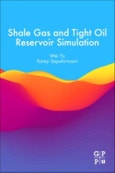Shale Gas and Tight Oil Reservoir Simulation delivers the latest research and applications used to better manage and interpret simulating production from shale gas and tight oil reservoirs. Starting with basic fundamentals, the book then includes real field data that will not only generate reliable reserve estimation, but also predict the effective range of reservoir and fracture properties through multiple history matching solutions. Also included are new insights into the numerical modelling of CO2 injection for enhanced oil recovery in tight oil reservoirs. This information is critical for a better understanding of the impacts of key reservoir properties and complex fractures.
Please Note: This is an On Demand product, delivery may take up to 11 working days after payment has been received.
Table of Contents
1. Introduction of Shale Gas and Tight Oil Reservoirs2. Numerical Model for Shale Gas and Tight Oil Simulation
3. Semi-Analytical Model for Shale Gas and Tight Oil Simulation
4. Modeling Gas Adsorption in Marcellus Shale Using Langmuir and BET Isotherms
5. Embedded Discrete Fracture Model (EDFM) for Complex Fracture Geometry
6. An Integrated Framework for Sensitivity Analysis and Economic Optimization in Shale Reservoirs
7. An Assisted History-Matching Workflow Using a Proxy-Based Approach for Shale Reservoirs
8. CO2 Injection for Enhanced Oil Recovery in Tight Oil Reservoirs
9. Phase Behavior Modelling by Considering Nanopore Confinement
Authors
Wei Yu Chief Technology Officer, Sim Tech LLC, Houston, Texas, USAResearch Associate, Hildebrand Department of Petroleum and Geosystems Engineering, University of Texas at Austin, TX, USA. Dr. Wei Yu is the chief technology officer for Sim Tech LLC and a research associate in the Hildebrand Department of Petroleum and Geosystems Engineering at The University of Texas at Austin. He is an Associate Editor for the SPE Journal and the Journal of Petroleum Science and Engineering. His research interests include EDFM (Embedded Discrete Fracture Model) technology for modeling any complex fractures, shale gas and tight oil reservoir simulation, EDFM-AI for automatic history matching and complex fracture characterization. Yu has authored or coauthored more than 200 technical papers and two books (Shale Gas and Tight Oil Reservoir Simulation and Embedded Discrete Fracture Modeling and Application in Reservoir Simulation), and holds five patents. He holds a PhD degree in petroleum engineering from The University of Texas at Austin. Kamy Sepehrnoori Professor, Hildebrand Department of Petroleum and Geosystems Engineering, The University of Texas at Austin, USA. Dr. Kamy Sepehrnoori is a professor in the Hildebrand Department of Petroleum and Geosystems Engineering at The University of Texas at Austin, where he holds the Texaco Centennial Chair in Petroleum Engineering. His research interest and teaching include computational methods, reservoir simulation, simulation of unconventional reservoirs, enhanced oil recovery modeling, flow assurance modeling, naturally fractured reservoirs, high-performance computing, and CO2 sequestration. He has been teaching at The University of Texas for over 35 years and has graduated more than 230 MS and PhD students under his supervision working mainly in the areas of reservoir simulation and enhanced oil recovery modeling. For the last several years, he has been supervising a research group in simulation of unconventional reservoirs (shale gas and tight oil reservoirs). Sepehrnoori's research team along with his colleagues have been in charge of development of several compositional reservoir simulators (i.e., UTCOMPRS, UTCHEMRS, and UTGEL). Also, more recently, he supervised the development of a software package for embedded discrete fracture modeling for application in naturally and hydraulically fractured reservoirs. He has published more than 650 articles in journals and conference proceedings in his research areas. He has also coauthored three books, which have been published by Elsevier. Sepehrnoori is the director of the Reservoir Simulation Joint Industry Project in the Center for Subsurface Energy and the Environment. He holds a PhD degree in petroleum engineering from The University of Texas at Austin.








